Overview
Augmented Reality (AR) significantly enhances project efficiency in construction by improving visualization, collaboration, and real-time decision-making. This advancement not only reduces errors and rework but also streamlines workflows. Research indicates that integrating AR with Building Information Modeling (BIM) facilitates on-site adjustments and enhances worker training. These applications contribute to increased productivity in construction projects, making AR an indispensable tool for industry professionals. As brand managers seek actionable insights, embracing AR technology is essential for staying ahead in the competitive construction landscape.
Introduction
Augmented reality (AR) is fundamentally reshaping the construction landscape by enhancing project efficiency in ways previously deemed unattainable. By integrating AR with traditional building practices, stakeholders are empowered to visualize intricate designs in real-time, which enables informed decision-making and significantly reduces costly errors. As the construction industry increasingly embraces this innovative technology, a critical question emerges: how can teams effectively leverage AR not only to streamline workflows but also to foster collaboration and enhance safety in an ever-complex environment?
Magic Playbox: Transforming Construction Projects with Immersive AR Solutions
Magic Playbox stands at the forefront of integrating AR for construction into building endeavors, delivering immersive solutions that significantly enhance visualization, collaboration, and overall efficiency. By harnessing AR for construction, stakeholders can visualize intricate designs in real-time, fostering informed decision-making and minimizing errors throughout the building process.
Tailored specifically for the unique needs of building teams, Magic Playbox's AR applications ensure that each task leverages the advantages of advanced technology and imaginative storytelling. This approach not only streamlines workflows but also cultivates a cooperative atmosphere, ultimately driving success.
As the building sector evolves, the integration of AR for construction is set to enhance productivity by minimizing rework and saving valuable time, making it an essential tool for modern building practices.
BIM Integration: Enhancing Project Visualization and Collaboration
Incorporating augmented reality (AR) with Building Information Modeling (BIM) significantly enhances visualization and teamwork in the building sector. AR for construction empowers teams to overlay digital models onto physical sites, providing a clear perspective on how designs will materialize in reality. This integration fosters real-time collaboration among architects, engineers, and contractors, ensuring alignment throughout the development lifecycle.
By visualizing the initiative in its actual environment, teams can proactively identify potential issues, leading to streamlined workflows and a notable reduction in rework. Research indicates that AR can aid in progress tracking and enhance accuracy by detecting mistakes early—an essential factor for managing large, intricate building sites.
As the building sector evolves, adopting AR for construction is becoming indispensable for enhancing accuracy and achieving overall success.
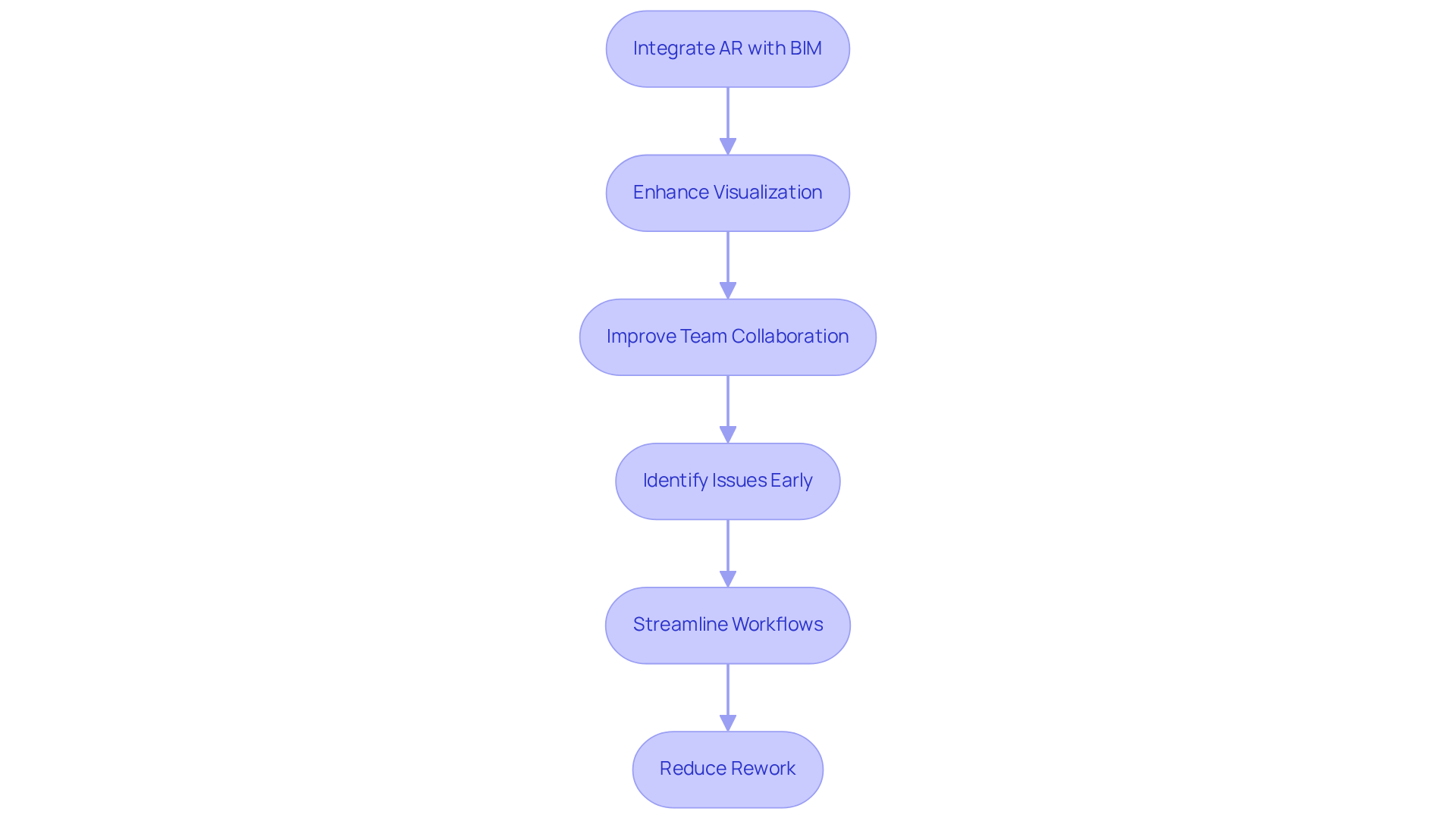
On-Site Project Planning: Real-Time Adjustments with Augmented Reality
Augmented reality is revolutionizing on-site planning by enabling real-time adjustments to designs and workflows. Construction teams can leverage AR to visualize changes instantly, providing immediate feedback and facilitating modifications. This capability proves invaluable during the construction phase, where unforeseen challenges frequently arise.
For instance, AR allows workers to view information about outlet locations, walls, pipes, and ventilation directly on-site, ensuring accurate hardware placement against the original designs. Moreover, the combination of Building Information Modeling (BIM) with AR enhances this process by enabling teams to compare real-time data with plans, maintaining accuracy and efficiency.
By utilizing AR, teams can dynamically adapt their plans, which helps maintain project schedules and budgets. Furthermore, AR can enhance safety on building sites by offering task-specific safety checklists and visualizations. As AR for construction technology continues to evolve, its integration is expected to streamline operations, enhance collaboration, and significantly reduce the time spent on quality control and inspections in construction processes.
This innovative approach not only improves efficiency but also fosters better communication among project stakeholders, ultimately leading to more successful project outcomes. As Naveen Joshi noted, "AR can boost overall operational efficiency and precision, leading to improved client relations and satisfaction.
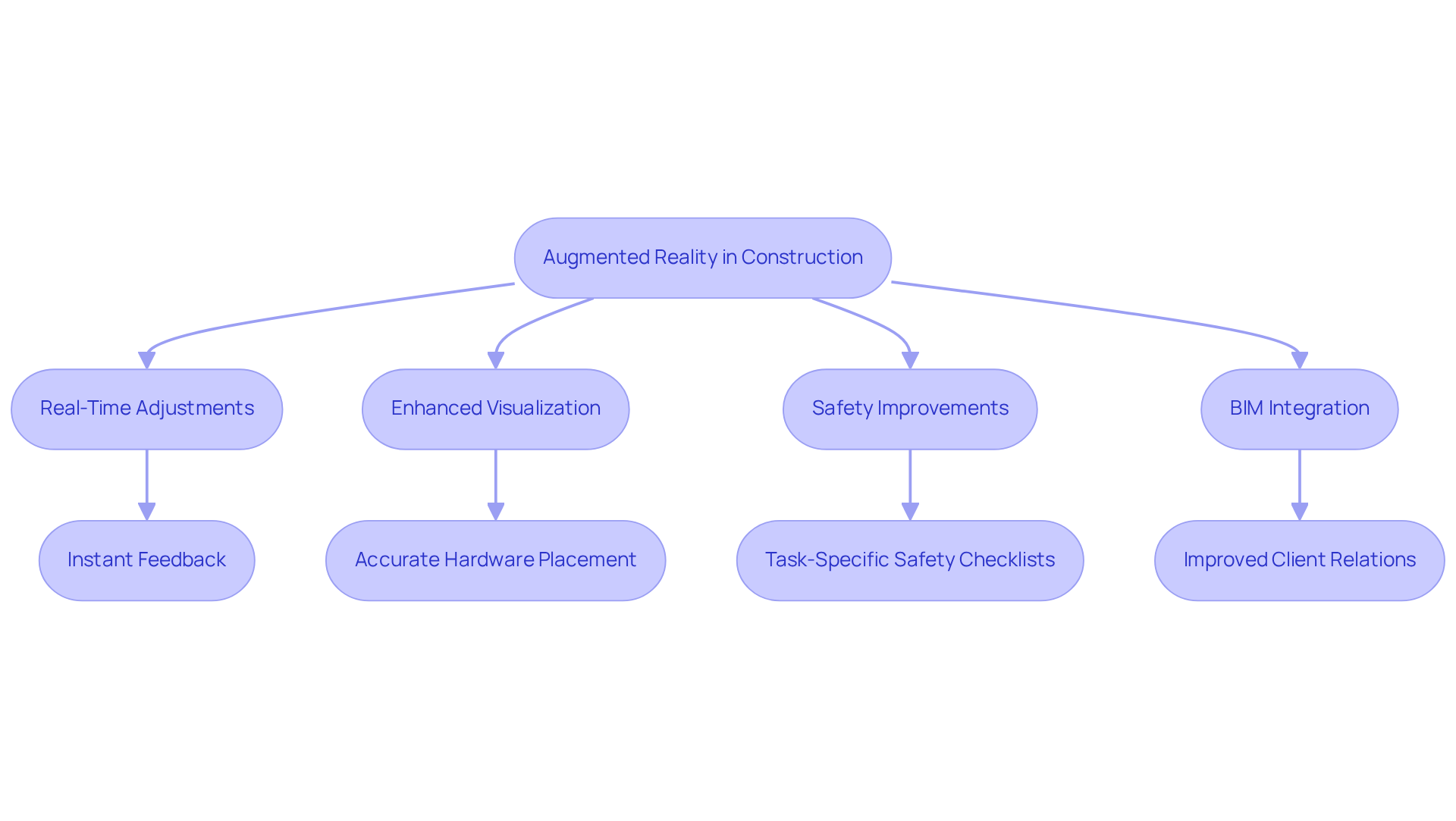
Worker Training: Enhancing Safety and Efficiency through AR
Augmented Reality (AR) significantly enhances worker development by delivering immersive, interactive experiences that prioritize safety and operational efficiency. AR for construction enables workers to engage in realistic task practice within a controlled environment, allowing them to gain hands-on experience without the inherent dangers of on-site instruction. This innovative approach not only boosts workers' confidence but also equips them with the essential skills to navigate their roles effectively. Consequently, job sites become safer, and overall operational efficiency improves.
Notably, research indicates that organizations utilizing AR training experience a 54% reduction in troubleshooting time, which leads to decreased downtime and improved return on investment. Furthermore, trainers emphasize that AR simulations foster a deeper understanding of protocols, which is crucial for reducing accident severity and frequency. As one trainer remarked, 'The immersive nature of this innovative technology enables participants to repeat exercises without distractions, promoting a deeper comprehension of procedures.'
By integrating AR for construction into educational programs, construction companies can ensure their workforce is well-prepared, ultimately transforming safety standards and operational practices within the industry. Moreover, with 82% of firms adopting AR/VR indicating that the benefits exceed expectations, the case for AR educational solutions becomes even more compelling. Given the current skills gap, where 66% of U.S. workers feel the need to acquire new skills, AR training solutions are essential for equipping the workforce for the challenges that lie ahead.
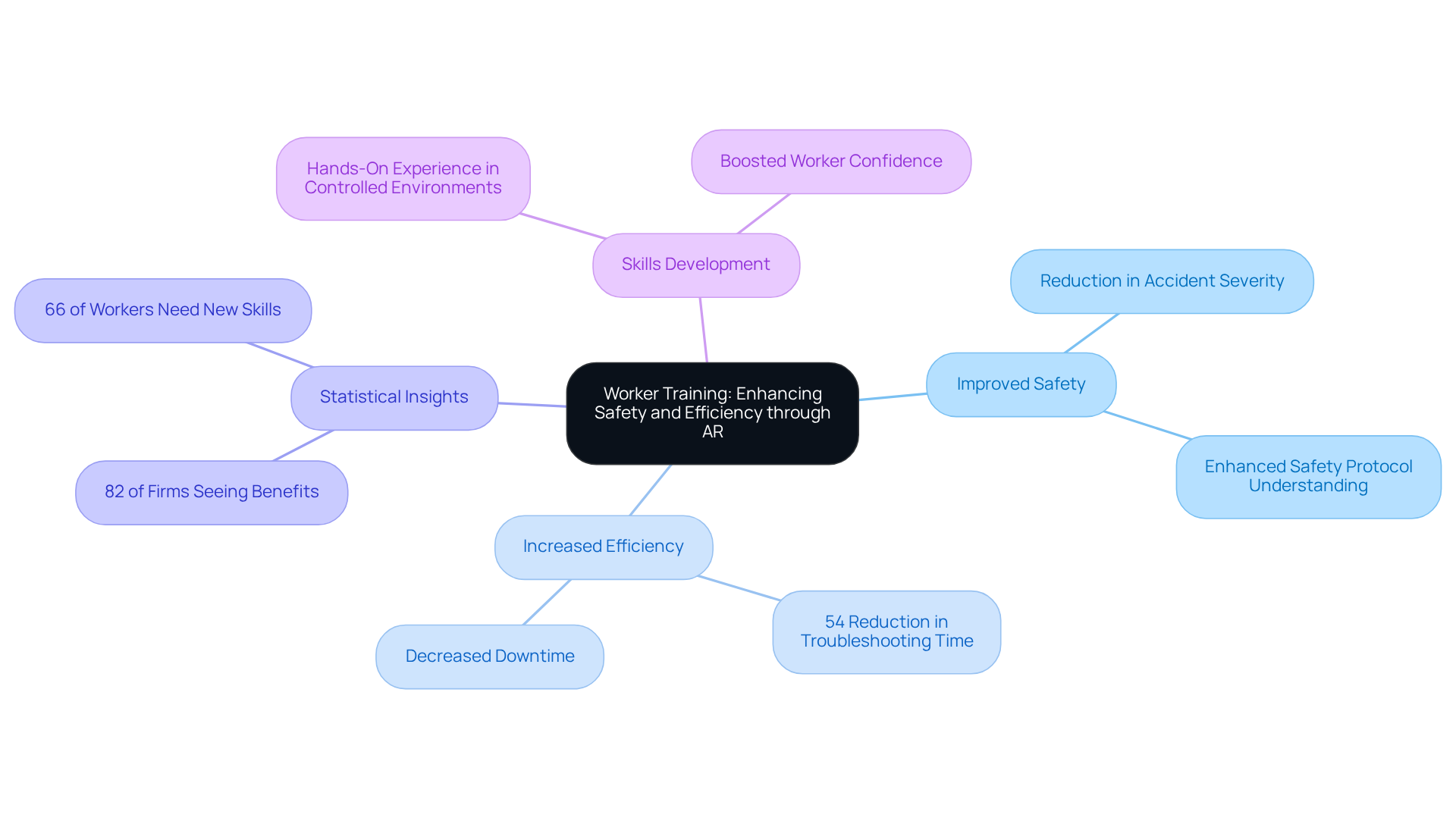
Collaboration Tools: Streamlining Communication with Augmented Reality
Augmented reality (AR) is revolutionizing teamwork in the building industry by significantly enhancing communication among stakeholders. This technology empowers teams to share visual information in real-time, leading to clearer discussions and expedited decision-making. For instance, building experts can leverage AR to conduct remote site inspections, ensuring that all team members, irrespective of their location, have access to the same critical information. This capability not only boosts collaboration but also yields superior outcomes and fosters a more cohesive team environment.
The integration of AR tools, such as smart glasses, facilitates hands-free communication, enabling workers to share live video feeds and notes directly from the job site. This real-time exchange of information aids in promptly resolving design issues, thereby reducing the time and costs associated with miscommunication. A notable example is the synergy of AR with Building Information Modeling (BIM), which allows teams to overlay digital models onto physical sites, enhancing visibility and proactive problem-solving.
Moreover, AR’s ability to overlay digital indicators on building sites underscores potential hazards and safety protocols, further amplifying communication efficiency. As project managers have observed, the clarity afforded by AR tools can lead to a substantial reduction in misunderstandings, ultimately enhancing team dynamics and project success. With the building sector grappling with increasing complexity and demand-side pressures, the strategic adoption of AR is proving indispensable for effective communication and collaboration. Furthermore, given that the building sector experiences injury rates 71% higher than those in other industries, the importance of AR in enhancing safety through improved communication cannot be overstated.
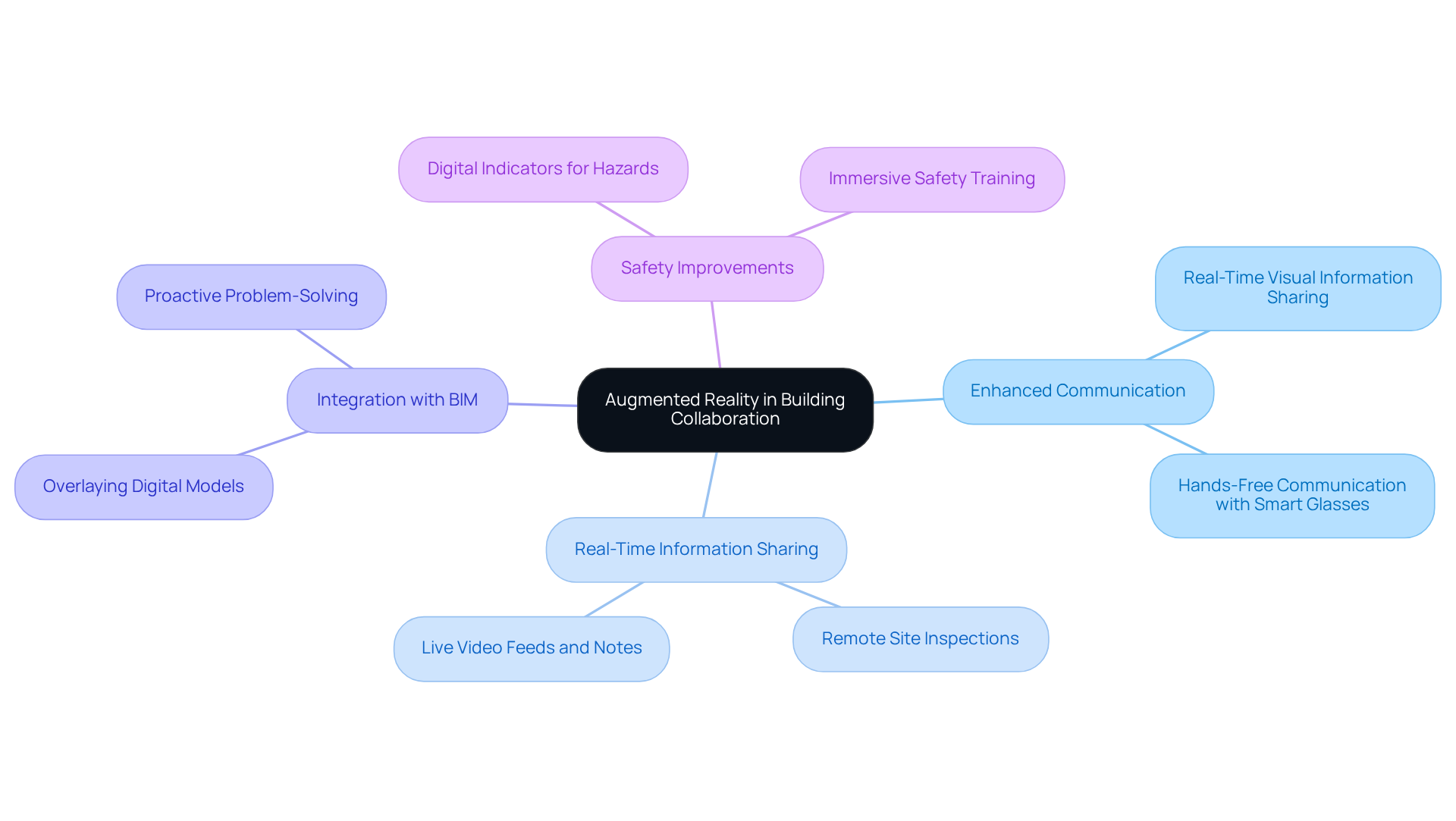
Virtual Site Inspections: Assessing Progress with Augmented Reality
Virtual site assessments, enhanced by augmented reality (AR), empower managers to evaluate development progress remotely. By leveraging AR technology, managers gain access to real-time data and visual representations of the site, which facilitates the monitoring of work quality and adherence to schedules. This innovative approach not only reduces travel costs and time but also allows for the swift identification of issues requiring immediate attention, ensuring that projects remain on track.
Research indicates that AR can enhance collaboration and communication among construction teams by up to 30%. Furthermore, a study conducted by the University of Cambridge reveals that integrating AR for construction can reduce errors by up to 50%, significantly improving overall accuracy.
As the construction sector embraces these advancements, the projected growth of the AR construction market from $0.3 billion in 2020 to $1.4 billion by 2025 highlights AR's transformative potential, establishing it as an indispensable tool in contemporary project management.
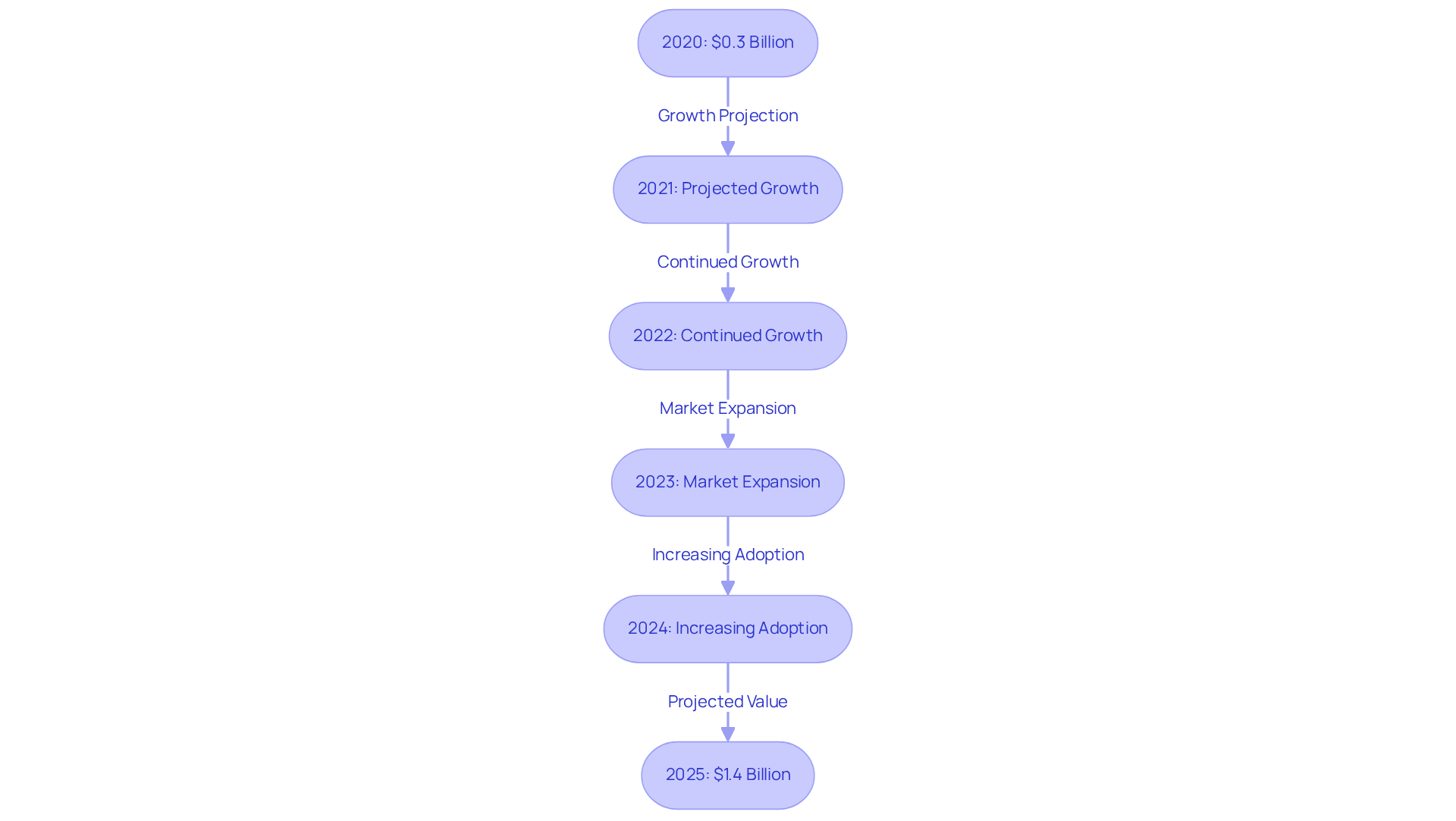
Safety Training: Realistic Simulations for Enhanced Worker Safety
Safety instruction enhanced by augmented reality (AR) provides workers with realistic simulations that prepare them for potential hazards on the job site. AR effectively simulates hazardous situations in a secure environment, enabling workers to rehearse their reactions and understand precautionary measures. This engaging instructional method not only enhances retention of security information—demonstrating an average rise of 76% in memory recall compared to conventional techniques—but also fosters a culture of awareness among employees, ultimately reducing the likelihood of incidents. Furthermore, VR instruction has shown a 50% decrease in the direct time required to complete staff security education, highlighting both efficiency and retention.
Experts in the field underscore the importance of AR simulations in hazard preparation. For instance, AR technology overlays real-time information onto physical environments, allowing workers to visualize risks and respond appropriately. This proactive approach to risk management is vital, especially in high-risk sectors like construction, where AR for construction can significantly impact the stakes. Notably, 91% of companies are already utilizing or planning to adopt AR or VR technology, emphasizing the growing significance of these tools in maintaining secure operations.
Organizations that have integrated AR education report significant improvements in risk management, with immersive simulations enabling emergency responders to practice high-pressure scenarios without actual dangers. For example, Amerisure's implementation of VR protective instruction has garnered positive feedback, and Verizon has experienced a notable reduction in training duration through similar techniques.
Realistic AR simulations, such as those developed by industry leaders, empower trainees to interact with 3D representations of hazardous areas, gaining essential hazard awareness without exposure to physical dangers. Gravity Jack's AR technology exemplifies this innovation, allowing workers to engage with detailed virtual models superimposed on their physical environment. This cutting-edge development not only prepares workers for emergencies but also enhances their overall competency, leading to safer work environments and improved operational efficiency. As the construction sector continues to evolve, the integration of AR for construction into risk management training is becoming standard practice, ensuring that workers are adequately equipped to tackle the challenges they may face on the job.
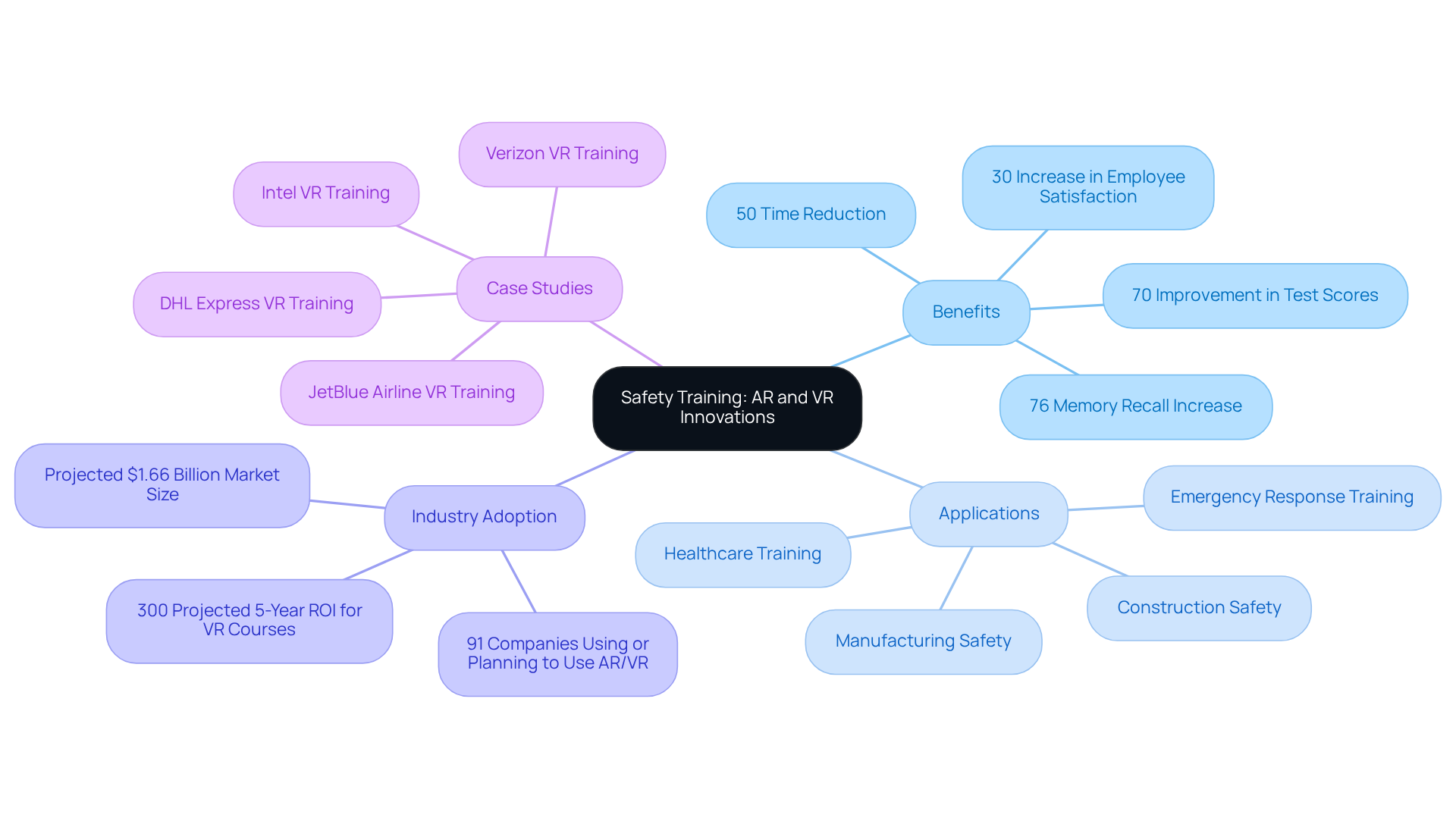
Structural Analysis: Visualizing Integrity with Augmented Reality
AR for construction significantly enhances structural analysis by enabling engineers to visualize the integrity of structures in real-time. AR for construction enables the assessment of load distributions, stress points, and potential weaknesses by overlaying digital models onto physical structures. This capability is essential for making informed decisions regarding necessary reinforcements or adjustments, ensuring that structures not only comply with standards but also function as intended.
For instance, using AR for construction software like Trimble SiteVision, construction teams can visualize site characteristics and overlay real-time data, accurately plotting up to 18,000 points of acceleration data in real-time. This innovation eliminates the need for hard-copy documents and enhances the assessment process.
Engineers have observed that using AR for construction can transform structural health monitoring by offering prompt access to essential data during inspections, thereby enhancing security and prolonging the lifespan of infrastructure. As Micheal Sakr stated, 'AR overlays digital information onto physical structures, offering an intuitive interface for onsite inspection, maintenance, and repair, ultimately optimizing safety and extending the lifespan of infrastructure.'
This technology not only improves task efficiency but also addresses the challenges faced by conventional structural health monitoring techniques, which often suffer from delays in data processing. Furthermore, with one-third of America’s infrastructure vulnerable to rapid deterioration, the urgency of implementing AR for construction assessments cannot be overstated.
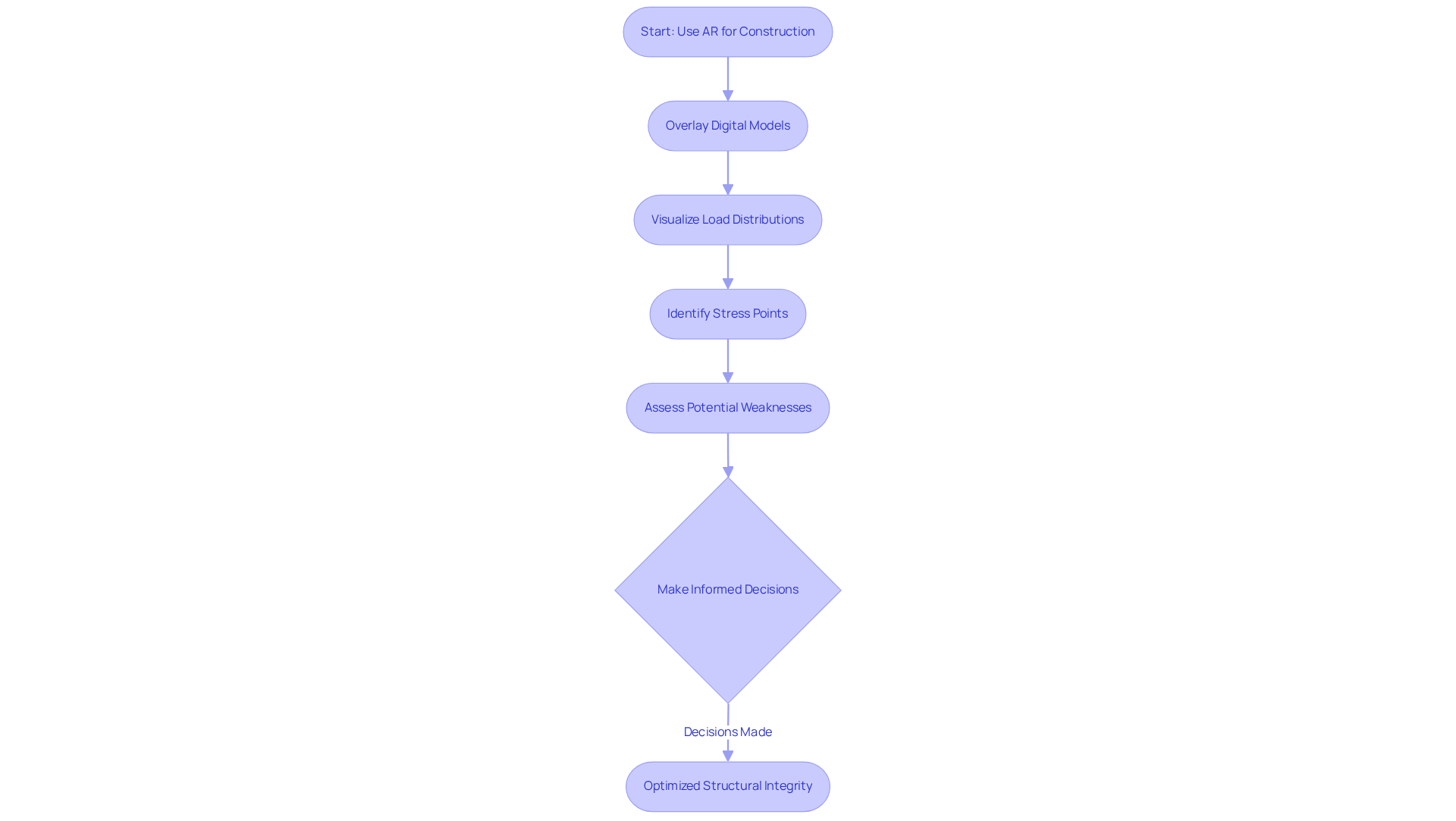
Prefabrication Validation: Ensuring Component Fit with AR
AR for construction significantly enhances the prefabrication process by validating component fit before materials arrive on-site. By leveraging AR for construction, building teams can visualize how prefabricated components will integrate into the overall design, enabling them to identify potential problems early in the lifecycle. This proactive approach minimizes the risk of costly rework and delays while enhancing overall project efficiency. Research indicates that the integration of AR for construction with building information modeling (BIM) has been shown to reduce rework and improve site productivity, further supporting these efficiency claims.
For instance, a building management firm utilized AR to detect design discrepancies during the installation of rainwater pipes, saving over three weeks of predicted rework. Such early identification of positional issues ensures that components fit correctly, streamlining the construction process.
Construction teams have observed that using AR for construction tools enhances collaboration and communication among stakeholders, as they can visualize the initiative in real-time. A spokesperson from AECOM noted the transformative effect of AR for construction in prefabrication, stating that it enables prompt adjustments and informed decision-making, ultimately resulting in smoother execution.
Moreover, AR for construction applications can validate prefabricated components before shipping. PCL Construction demonstrated this by using Microsoft's HoloLens for virtual assembly. This capability not only enhances accuracy but also fosters confidence in the prefabrication process, ensuring that all components align with the specifications. The collaborative aspect of AR for construction and BIM integration is crucial for identifying challenges and maximizing ROI, underscoring the importance of stakeholder cooperation in the prefabrication process.
In summary, the use of AR for construction serves as an essential instrument in guaranteeing component compatibility in building endeavors, enhancing efficiency and reducing the likelihood of mistakes that may lead to delays and increased expenses.
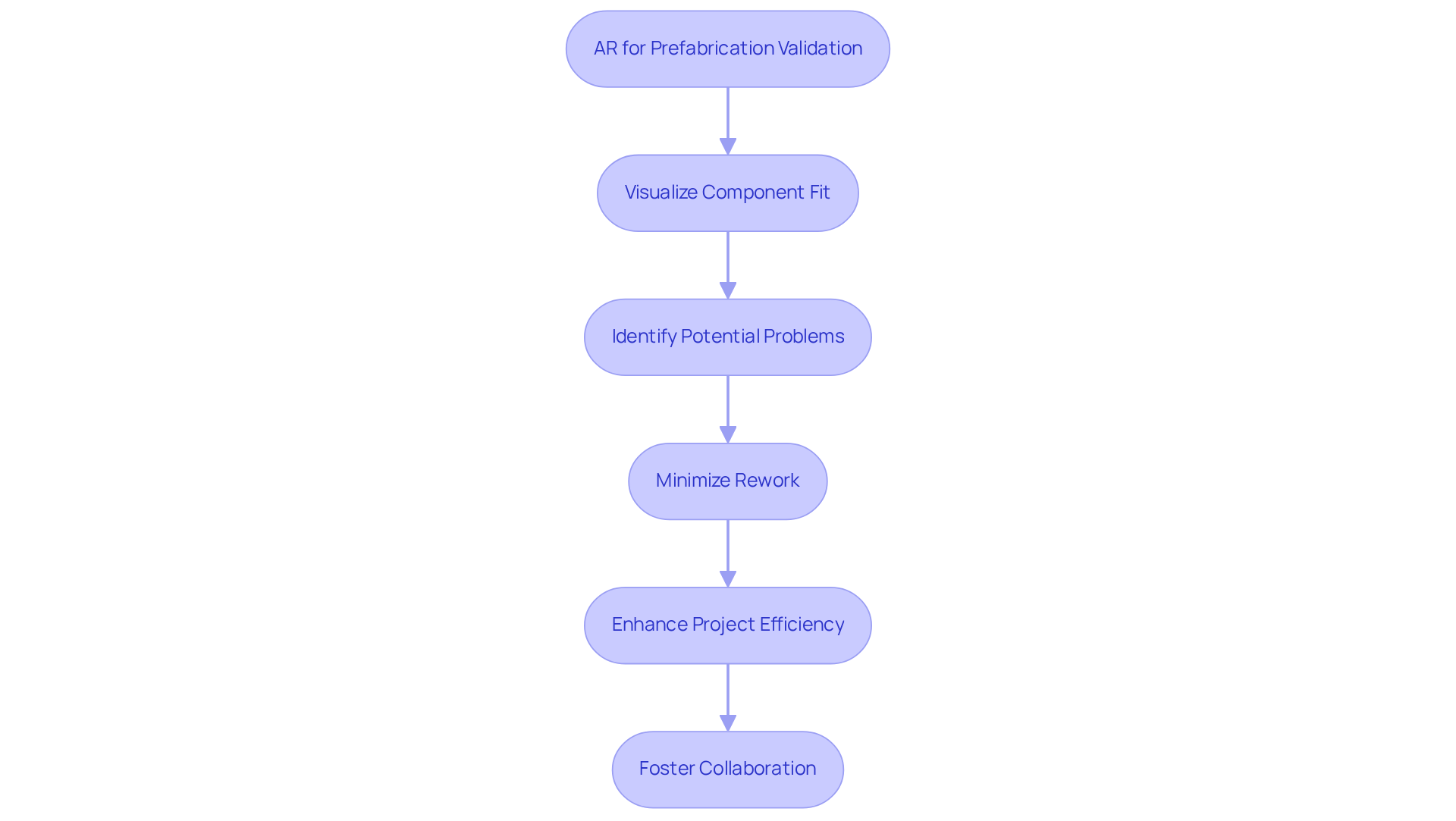
Marketing and Sales: Engaging Clients with Interactive AR Presentations
AR for construction is revolutionizing marketing and sales strategies within the building sector by offering interactive displays that captivate clients and showcase developments in an engaging manner. Magic Playbox's cutting-edge AR for construction solutions empower clients to visualize designs and navigate through virtual models, significantly enhancing the client experience while cultivating deeper connections and trust. This innovative approach not only sparks client interest but also enables construction firms to distinguish themselves in a competitive landscape.
Notably, the integration of Magic Playbox's AR for construction technology with Building Information Modeling (BIM) facilitates real-time collaboration and visualization, thereby enhancing accuracy and efficiency. Furthermore, research indicates that AR tools developed by Magic Playbox can boost sales by up to 80%, underscoring their potential to drive substantial business growth.
As firms increasingly embrace AR for construction, they are not only elevating client presentations but also streamlining communication and collaboration among stakeholders, ultimately leading to more successful project outcomes.
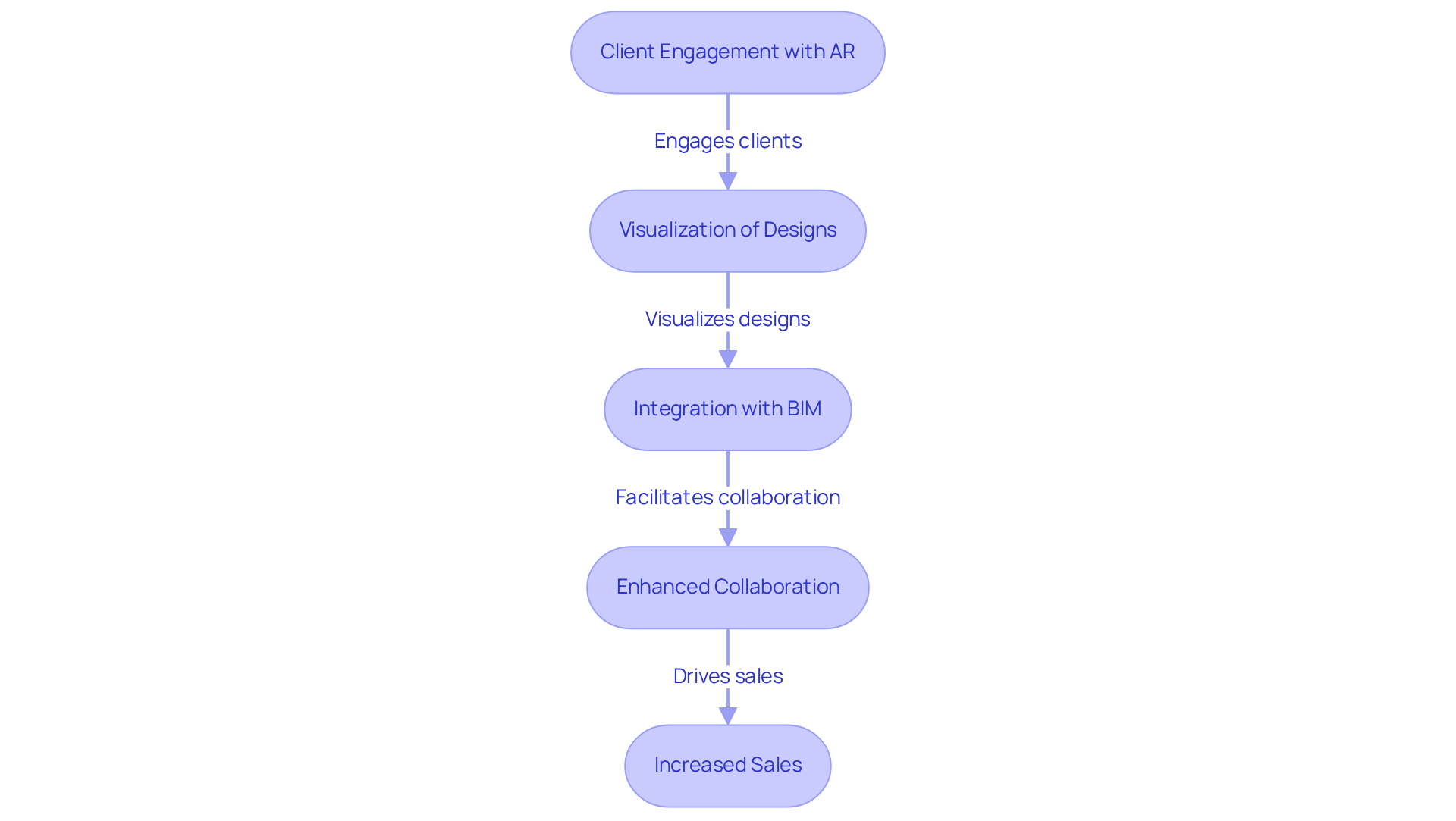
Conclusion
The integration of augmented reality (AR) into the construction industry is not just enhancing project efficiency and effectiveness; it is revolutionizing them. By significantly improving visualization, collaboration, and communication, AR emerges as a critical tool for modern construction practices. This technology streamlines workflows, minimizes errors, and reduces rework, resulting in substantial time and cost savings throughout the project lifecycle.
Key benefits of AR in construction are numerous and compelling:
- Improved on-site planning
- Enhanced worker training
- Effective structural analysis
Moreover, the synergy between AR and Building Information Modeling (BIM) amplifies these benefits, enabling real-time adjustments and fostering a collaborative environment among all stakeholders. From virtual site inspections to prefabrication validation, AR is proving indispensable for enhancing accuracy and safety in construction.
As the construction sector continues to evolve, embracing AR technology has transitioned from being a luxury to an absolute necessity. Companies that adopt these innovative solutions will not only enhance operational efficiency but also improve client engagement and satisfaction. The future of construction is firmly rooted in leveraging AR to create safer, more efficient, and more collaborative environments, ensuring that projects are completed on time and within budget. The time to act is now—embrace AR and redefine the standards of construction excellence.
Frequently Asked Questions
What is Magic Playbox and how does it enhance construction projects?
Magic Playbox integrates augmented reality (AR) into construction projects, providing immersive solutions that improve visualization, collaboration, and efficiency. It allows stakeholders to visualize designs in real-time, facilitating informed decision-making and reducing errors during the building process.
How does AR for construction benefit building teams?
AR applications from Magic Playbox are tailored to the specific needs of building teams, streamlining workflows and fostering a cooperative atmosphere. This integration enhances productivity by minimizing rework and saving time, making AR an essential tool in modern construction practices.
What is the role of BIM integration with AR in construction?
Integrating augmented reality with Building Information Modeling (BIM) enhances visualization and teamwork. AR allows teams to overlay digital models onto physical sites, enabling real-time collaboration among architects, engineers, and contractors, which helps in identifying potential issues early and reducing rework.
How does AR improve on-site project planning?
Augmented reality revolutionizes on-site planning by allowing construction teams to make real-time adjustments to designs and workflows. It provides immediate feedback and visualizes changes, helping teams to accurately place hardware according to original designs and maintain project schedules.
In what ways does AR contribute to safety on construction sites?
AR enhances safety by providing task-specific safety checklists and visualizations, ensuring that workers are aware of potential hazards and proper procedures. This integration helps improve overall safety on building sites.
What future developments can be expected from AR in the construction industry?
As AR technology continues to evolve, its integration is expected to further streamline operations, enhance collaboration, and significantly reduce time spent on quality control and inspections, ultimately leading to improved efficiency and client satisfaction.




